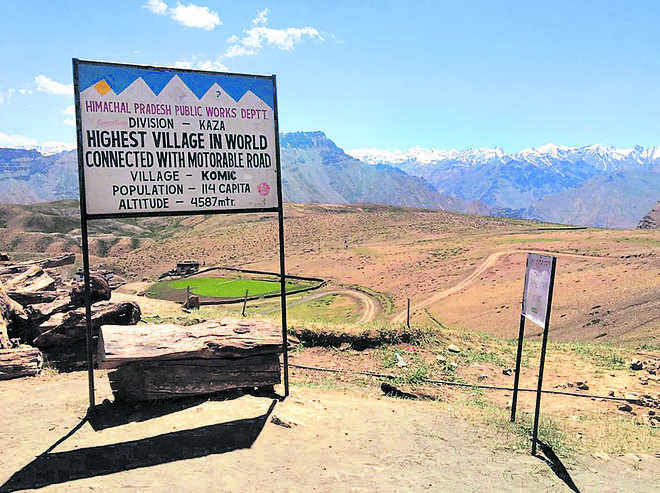World’s ‘highest’ village runs dry as warming hits Himalayas
Page 1 of 1
 World’s ‘highest’ village runs dry as warming hits Himalayas
World’s ‘highest’ village runs dry as warming hits Himalayas

Komik (HP), August 1
With a backdrop of the snow-capped Himalayas stretched out across a vibrant blue sky, it is hard to dispute the sign as you enter Komik that declares it to be the world’s highest village with a road.
Others also boast the title — from Nepal’s Dho Tarap to Bolivia’s Santa Barbara. But at 4,587 metres (15,050 feet), this remote Buddhist hamlet in Himachal Pradesh near India’s border with Tibet is no doubt among the planet’s topmost motorable human settlements.
Yet despite its coveted status, life is harsh for the 130 residents of Komik, a quaint collection of whitewashed mud-and-stone houses located in the desolate Spiti valley.
The region is a cold trans-Himalayan desert cut off from the rest of India for six months of the year when snowfall blocks mountain passes. Phone and Internet connectivity is almost non-existent. Schools and clinics are a tough trek away.
But Spiti’s inhabitants, who eke out a living farming green peas and barley, have a much bigger concern: their main sources of water — streams, rivers, ponds — are drying up.
“We are used to being in a remote place. We have our traditional ways of living,” said farmer Nawang Phunchok, 32, as he sat tying bundles of a prickly desert bush to insulate a monastery roof.
“But these days the water is not coming like it used to. The seasons are changing. We see there is less water than before.” There is little doubt India is facing a water crisis.
Decades of over-extraction of ground water, wasteful and inefficient irrigation practices, pollution of surface water like lakes and rivers, and erratic weather patterns attributed to climate change, have left many parts of the country thirsty.
From its deepest aquifers to its biggest rivers, India is one of the most water-challenged countries in the world. More than half of the country, including Punjab and Haryana, is considered highly water-stressed.
More than 50 per cent of the country’s wells have registered a decline in volumes in the last decade. Up to 80 per cent of rivers, lakes, ponds and streams are polluted with human waste and sewage.
Over 6.3 crore rural Indians do not have clean water to drink, cook or wash with, says WaterAid. Around 7.6 crore need improved water sources and 77 crore require proper toilets. And climate change is exacerbating the situation.
Overall rainfall in the last century has been erratic, and the annual average temperature has risen by 0.5 degrees Celsius, says India’s meteorological department.
India is forecast to overtake China as the most populous nation with 1.7 billion people by 2050. With rapid urbanisation, rising demand for hydropower and changing weather patterns, the situation is set to worsen.
Government data forecasts India’s annual water availability per person to drop by over 25 per cent by 2050 to 1,140 cubic metres from 1,545 cubic metres in 2011.
Authorities have in recent years moved to better support farmers and boost water security in drought-prone areas. But environmentalists say the focus is largely on plains.
The Himalayas are one of the world’s most sensitive hotspots to climate change. Melting glaciers, erratic rainfall, less snow and rising temperatures are taking their toll. And Spiti valley — “Middle Land” (between India and Tibet) — is showing the signs. From April to September, locals farm tiny plots before winter sets in and temperatures drop to minus 30°C. Spiti’s water comes from snow — snowfall provides the moisture for farming and pastures for livestock rearing, while snow melt from glaciers feeds streams and rivers which are the lifeline of these settlements. And unlike in other parts of India where there are two farming seasons, in Spiti there is only one — leaving farmers more vulnerable if one crop fails.
It has become warmer over the last few decades and there is less snowfall, say residents. The winters have become shorter and summers longer, they add. Their main form of irrigation which are “kuls” — man-made channels running from glaciers to village ponds — are dry. As a result, herders have to trek higher to find grazing land and crops are much harder to cultivate.
“There is no doubt there is a water crisis here,” said SDM Arun Sharma. “We’ve put in place projects such as providing tanks and constructing catchment areas, but we are limited by the weather. For six months of the year, life stops as we are snowbound and we cannot do any work.” — Reuters
http://www.tribuneindia.com/news/himachal/world-s-highest-village-runs-dry-as-warming-hits-himalayas/445896.html
 Similar topics
Similar topics» A heart warming tale from the former world's second biggest airline
» Which Country has the Highest Rape Rate in the World?
» Indian scientists find a ‘wonder herb’ in the high Himalayas
» 80 charts that show global warming hysteria is a fraud
» World keeps moving forward, world never dies, world never stops. Something will happen.
» Which Country has the Highest Rape Rate in the World?
» Indian scientists find a ‘wonder herb’ in the high Himalayas
» 80 charts that show global warming hysteria is a fraud
» World keeps moving forward, world never dies, world never stops. Something will happen.
Page 1 of 1
Permissions in this forum:
You cannot reply to topics in this forum